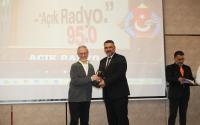War on Terrorism: War lords
Independent, 22 November 2001
The desperate men holding out inside the besieged Taliban stronghold of Kunduz in northern Afghanistan are no strangers to murder and massacre – the two most senior Taliban commanders in the city have both been linked to one of the worst massacres that took place in Afghanistan under the Taliban, in which a 16-year-old boy was skinned alive.
And a close ally of Osama bin Laden, a Chechen warlord with a reputation for cutting the throats of Russian prisoners-of-war in public, is the leader of the 2,000 al-Qa'ida fighters also holed up inside Kunduz vowing to fight to the death.
There are growing and well-founded fears of a potential bloodbath in the city. As many as 20,000 Taliban fighters are trapped inside, according to the Northern Alliance, whose forces are besieging Kunduz. The Alliance is desperately trying to negotiate a surrender, but says that more than 10,000 foreign Taliban volunteers, including some 2,000 al-Qa'ida fighters, are vowing to fight to the death.
The United States has harmed hopes of a peaceful surrender. The Defence Secretary, Donald Rumsfeld, said he would rather the al-Qa'ida fighters were killed or imprisoned than allowed safe passage to a third country, as the Taliban have been asking.
And the United Nations, which the Taliban was calling on to guarantee a safe passage for the foreigners, has said it does not have the means to organise one.
If more blood is spilled in Kunduz, the leaders of those trapped inside are men already steeped in it.
The man in charge of Mr bin Laden's men inside Kunduz has been named by the Northern Alliance as Omar al-Khatab. He is known to be an associate of Mr bin Laden, who has had links with him since the eighties, according to Russian intelligence. He fought as a warlord in Chechnya, and the Russians have accused him of triggering the 1999 war in Chechnya by invading the neighbouring Russian republic of Dagestan. He is an ethnic Arab of mixed Saudi and Jordanian descent, and is known for using car bombs.
The Northern Alliance has claimed that most Afghan Taliban are prepared to surrender, and that it is the foreigners alone who are preventing them – all over Afghanistan, the foreigners are becoming the scapegoats for all the crimes of the Taliban.
The two most senior Taliban commanders in Kunduz, Mullah Mohammed Fazil, and Mullah Dadullah, recently travelled to Mazar-i-Sharif to meet the Uzbek warlord, General Rashid Dostum, and negotiate the city's surrender, according to General Dostum's people.
But Mullah Fazil and Mullah Dadullah are far from blameless – and the ruins of an Afghan town called Yakaolang is a testament to why. In January this year, in one of the worst massacres known to have taken place under the Taliban, at least 178 people were tortured and killed by Taliban forces in Yakaolang, a district of Bamiyan province, according to a confidential 55-page report, including eye-witness accounts, prepared by the UN. One of the victims was a 16-year-old boy skinned alive "from head to chest". His body was dumped behind the offices of the British charity Oxfam.
Witnesses interviewed by the Revolutionary Association of the Women of Afghanistan describe unarmed civilians being lined up, their hands tied with their turbans, and then shot in the back. Many were apparently killed by foreign fighters – possibly members of al-Qa'ida. Arab fighters carried long knives used for slitting throats and skinning victims, the witnesses said.
But the man in command of the massacre is named in the UN report as Mullah Fazil. He is the head of the Taliban's army corps, and the most senior Taliban leader believed to be in Kunduz. The report also says that Mullah Mohammed Omar, the Taliban's supreme leader, was in constant contact by radio with Taliban forces in Yakaolang while the massacres were being carried out.
Mullah Dadullah, the next most senior Taliban leader in Kunduz, has also been accused of involvement in the atrocities at Yakaolang in January. And, while Human Rights Watch says it has no evidence that he was in Yakaolang in January, he is known to have been in command of Taliban troops who committed a second "mopping-up operation" in the same town only six months later, in June this year.
Then, Taliban forces returned to the town and burnt it to the ground. Few people were still living in the town, but Mullah Dadullah's men killed many of those that were. His forces then went on the rampage through Bamiyan province, burning the tents of refugees who had fled into the mountains, and killing even the elderly who had stayed behind in the towns.
Mullah Dadullah – a former mujahedin leader who fought against the Soviets and is known to Afghans as Dadullah the lame – is a notorious killer, accused of taking part in massacres all over the country.
The Taliban claimed the motive for its operation in Yakaolang was to send a clear signal to opposition forces allied to the Northern Alliance, for whom it said the town was a base. But a more likely motive was ethnic cleansing. The majority of the victims were ethnic Hazara, who are Shia Muslims. The Hazara have been consistently persecuted for their religious beliefs – and the Taliban, who are Sunni Muslims, took it to new depths.
These are the men in whose hands the fate of Kunduz lies. Yesterday the Northern Alliance said it was distributing ammunition to its soldiers on the front lines around the city.
The accused
Omar al-Khatab
A Saudi-Jordanian warlord who brought his fierce brand of Islam to the Chechen conflict. Named by Russia's secret services as a source of money and logistical help for Islamist brigades who aided Chechen rebels against Russians. He unleashed the last war in Chechnya by leading a disastrous invasion of Dagestan in 1999. Notorious for car bombs and slitting the throats of Russian prisoners-of-war in public.
Mullah Dadullah
Known as Dadullah the lame, he is a senior Taliban commander in Afghanistan's northern zone and in some Taliban government lists is named as the Minister of Construction. He is a notoriously brutal man linked to the most serious atrocities of recent years – the massacre of Hazara civilians this year.
Mullah Fazil
Head of the Taliban Army Corps and a hardline member of the six-man Taliban ruling council. Responsible for numerous human rights abuses and a key link between the Taliban and al-Qa'ida fighters, including the massacre of Uzbeks in Mazar-i-Sharif.






